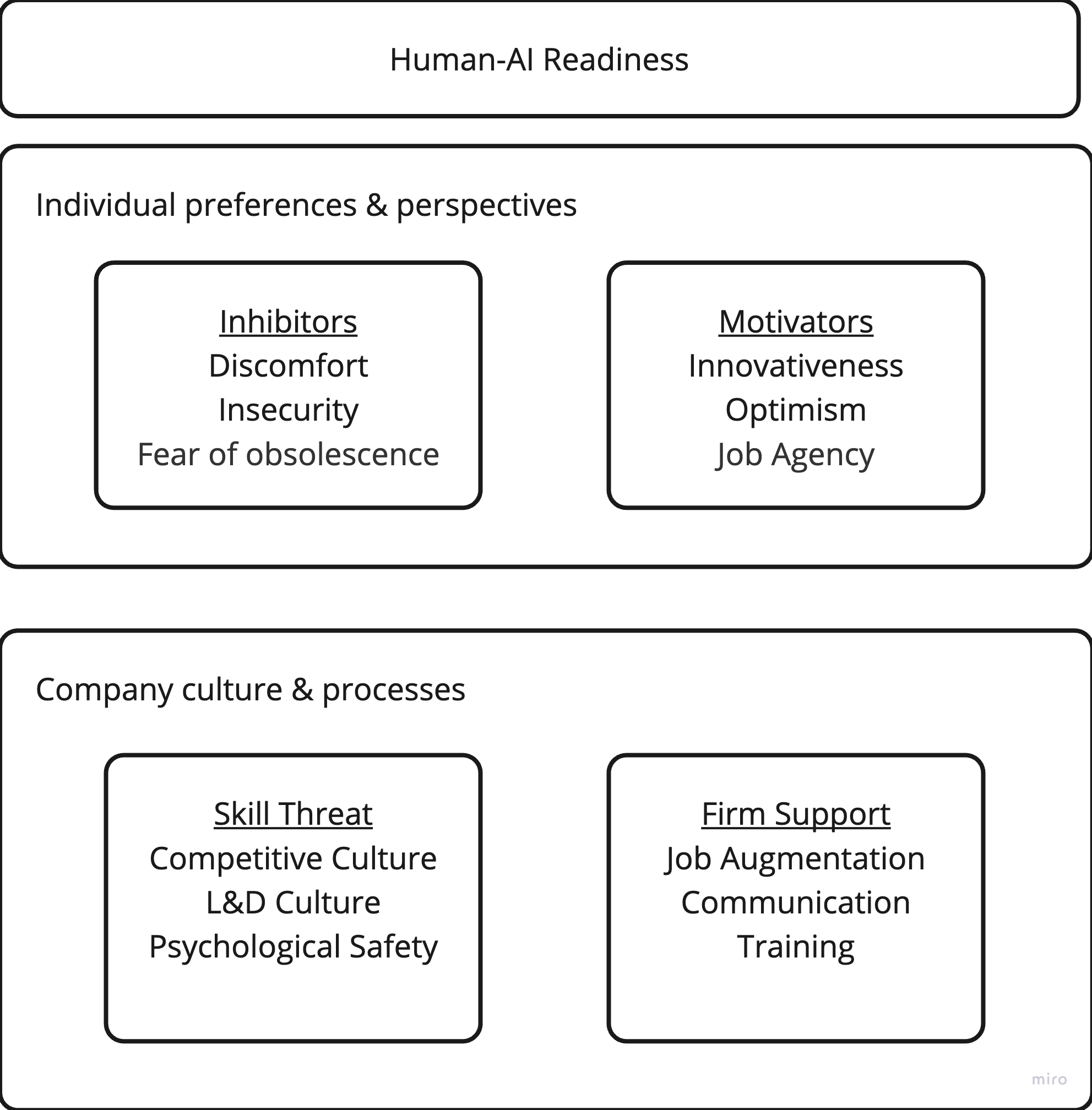You'll get deep dive essays, curated headlines, and plug-and-play methods for working with AI.
Stop Wasting Money on AI Until You Address This Hidden Readiness Gap
|
Everyone’s investing in agentic workflows, digital twins, open source LLMs, prompting, RAG, and LanguageGraphs. The list goes on and on… But the truth is that even with unlimited access to the best AI tools and systems, companies will waste millions if their workforces aren’t ready for change.
An unready workforce will subtly question the spend (and the leaders who approved it). To put it bluntly, without addressing the human side of technology adoption, you’re just wasting time, spinning your wheels. So, what invisible force is sabotaging your AI investments before they even have a chance to succeed? After studying the literature and working with dozens of companies, we’ve found that the culprit is almost always the same: critically low “human-AI readiness.” Today, we’ll discuss human-AI readiness: what it is and why it matters for successful AI adoption. (We’ll also tease our next issue on how to measure and increase it.) Human-AI Readiness DefinedCompanies like Intel have offered their own view of an AI-ready organization. One that gets the technical details right: strong system capabilities, readily available data, and a clear security posture. But human-AI readiness considers the psychological and emotional openness of people (both individually and collectively) toward technological change. In other words, human-AI readiness involves two major categories: individual preferences and perspectives, and company culture and processes. Let’s briefly break down each category: 1/ Individual preferences and perspectivesResearch on technology readiness reveals a key observation: we each have a natural predisposition toward new technology. Some people are naturally cautious about new tech, while others eagerly embrace it. Where exactly you fall on the resitant-motivated range depends on several key factors:
While these factors involve our natural wiring and tendencies, our job perceptions and our emotions are also relevant. Fear, of course, is an emotion that limits adoption. Specifically, the fear of becoming obsolete from AI use, or FOBO, has steadily risen since ChatGPT’s public release in 2022 While fear holds people back, other factors can accelerate adoption. Employees who feel a strong sense of control over their work (job agency) are more likely to experiment with AI tools. They see technology as another tool that enhances their control over how they perform and succeed in their jobs. Put simply, our natural technology tendencies combined with our perceptions create our individual-level readiness for AI - either accelerating our willingness to adopt or reinforcing our resistance.
2/ Company culture and processesHuman-AI readiness plays out differently at the team or company level. Back in 2018, Australian researchers defined organizational AI readiness as its “preparedness…to implement change…related to AI.” This definition is important. While individual differences, mindsets, and emotions determine personal AI use, company culture creates the norms and beliefs about what “OK” and “Not OK,” including which tools to use and when. Fascinating work from Pluralsight’s developer success lab discovered how culture influences behavior that drive adoption. They found that engineers who came from competitive cultures experienced greater more inhibition toward AI because of the threat it poses to their skills. In contrast, companies that prioritized learning and psychological safety were much more likely to view AI as a collaborative tool rather than a threat. While culture helps or hinders AI adoption in subtle ways, company processes also have a large impact on whether employees feel equipped and empowered to try new tools. Processes such as:
Each can accelerate early adopters and help skeptics overcome their fears through clarity and knowledge. Human-AI Readiness Is a Prerequisite to AI AdoptionWe’ve discussed how individual differences, perceptions, and emotions mix with your cultural norms, beliefs, and supportive practices to create a foundation upon which all your AI investments will either thrive or wither. AI adoption follows a clear sequence: readiness enables adoption, adoption drives maturity, and maturity generates value. Without establishing readiness first, the entire chain breaks down before it begins. I experienced this firsthand at my last job in the talent acquisition tech industry. When ChatGPT launched in late 2022, we faced dual challenges: understanding how candidates might use AI to "game" hiring assessments while simultaneously adapting to our clients' rapidly evolving talent needs. Despite the urgency, our organization's AI readiness levels were low. Leaders and employees approached AI with visible hesitation. And like many companies at that time, we lacked the psychological safety to try new things and the training resources needed to bridge the knowledge gap. The turning point wasn't a new technology investment or executive mandate. It came when a small group of adoption champions found creative ways to add AI into their daily work and openly shared their successes. Their stories created a ripple effect that gradually improved our collective readiness, leading to more adoption in the product and among the workforce. This experience taught me a helpful lesson: readiness isn't fixed, but it is foundational. Like fertile soil, AI readiness is where adoption can take root and flourish. Without tilling and preparing this soil, "planting" new tools in your company will lead to:
Next Steps: Assess Before You InvestBefore you approve another AI budget request or launch another pilot program, take a step back to evaluate your organization's true readiness. Ask yourself:
If you answered "no" to any of these questions, you have readiness work to do. Next time, we'll share our proven framework for measuring AI readiness across your organization, along with the five key interventions that can dramatically improve your readiness scores in under 90 days. Until then, remember: The most sophisticated AI tools in the world are worthless without humans ready to embrace them. |
Go from overwhelmed to in-demand AI Strategist (without hours of research)
You'll get deep dive essays, curated headlines, and plug-and-play methods for working with AI.
